The dumbbell tricep kickback is a single-joint, isolation exercise primarily designed to target and develop the triceps brachii.
Kickback engages all three; the specific position (bent-over, arm held back) emphasises the long head more, especially at the movement’s top. The lateral and medial heads are still working.
According to research by the American Council on Exercise (ACE), the tricep kickback ranks as the second most effective triceps exercise in terms of muscle activation, producing over 87% of maximal voluntary contraction. Only diamond push-ups scored higher in their comprehensive study of tricep exercises.
I’ve observed that clients who regularly incorporate tricep kickbacks into their routines experience noticeable improvements in their bench press strength and overhead pressing power.
To keep your workouts engaging and target your triceps from different angles, you can incorporate various dumbbell triceps kickback variations into your routine, such as:
- Standing Dumbbell Tricep Kickback
- Seated Dumbbell Tricep Kickback
- One-Arm DB Tricep Kickback
- Two-Arm Dumbbell Tricep Kickback
- Incline Dumbbell Tricep Kickback
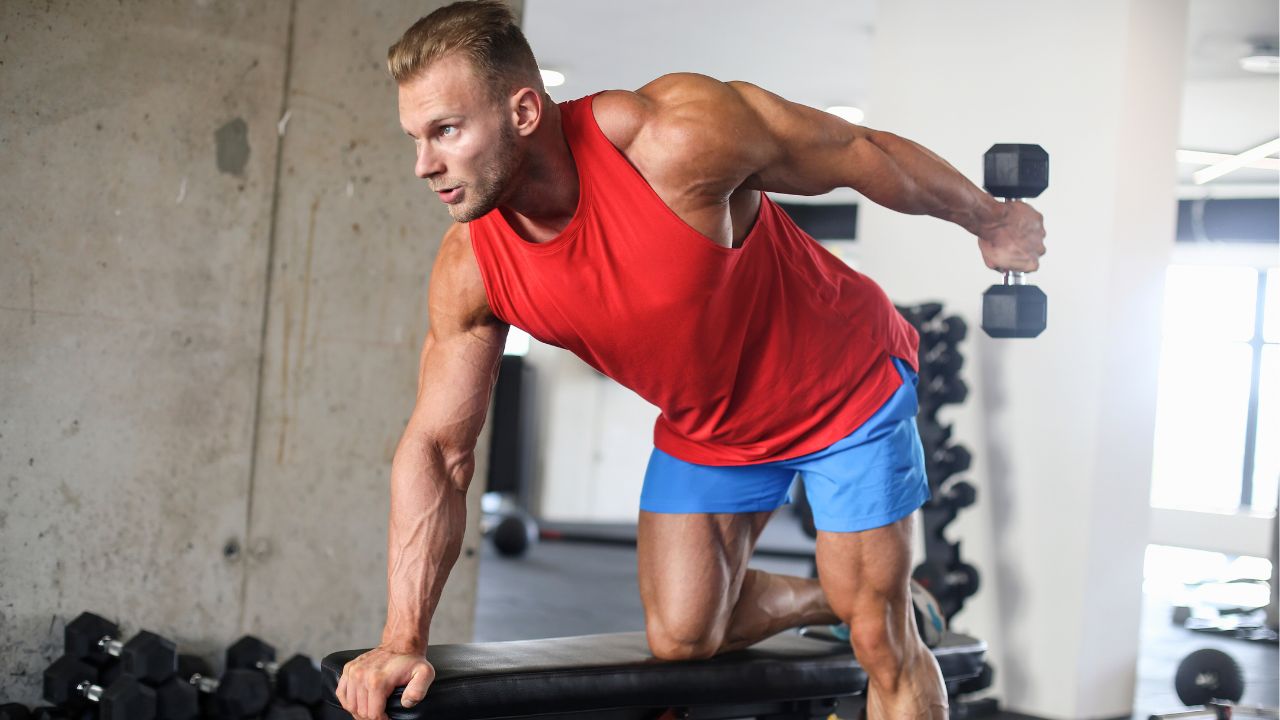
- Dumbbell Tricep Kickback Muscles Worked
- How To Do Dumbbell Tricep Kickback
- Form and Techniques
- Sets And Reps
- Best Variations Of DB Tricep Kickbacks
- 1. Seated Two-Arm Dumbbell Kickback
- 2. Standing Single Arm Dumbbell kickback
- 3. Two-Arm Dumbbell Standing Kickback
- 4. Incline Dumbbell Kickback
- FAQs
- Are dumbbell kickbacks effective?
- Do Tricep Kickbacks Work All 3 Heads?
- How Much Weight Should I Use For Tricep Kickbacks?
- References
Dumbbell Tricep Kickback Muscles Worked
- Primary Muscle: Triceps Brachii (Long head, lateral head, medial head), especially the long head in overhead variations.
- Secondary Muscles: Anconeus, Deltoids (Anterior head)
- Stabilizer Muscles: Core (Rectus abdominis, obliques), Trapezius & Rhomboids and Forearm muscles
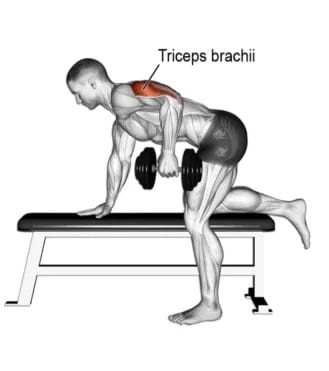
How To Do Dumbbell Tricep Kickback
- Pick a weight that’s right for you. A good starting point is usually between 5–15 pounds.
- Place your right knee and hand firmly on a flat bench, directly under your shoulder. Your back should be flat and parallel to the floor.
- Your left foot is planted on the floor, slightly out to the side for balance.
- Grip the dumbbell in your leftt hand with a neutral grip (palm facing your body).
- Draw the working elbow up so your upper arm (humerus) is parallel to the floor and tight against your torso. Your elbow should be bent at 90 degrees, with the dumbbell hanging directly below it.
- Keep your upper arm completely stationary, exhale and extend your forearm straight back by contracting your tricep. Focus on moving only from the elbow joint.
- Inhale and slowly, with full control, lower the dumbbell back to the 90-degree starting position. This controlled negative is just as important as the kickback itself.
- Repeat for the desired number of repetitions, then switch sides and repeat the exercise with your left arm.
Form and Techniques
- Your torso should be parallel to the floor, or as close as possible. Maintain a neutral spine – flat from your head to your tailbone.
- Actively think about the tricep muscle working. Visualise it contracting and lengthening. If you can’t feel it, the weight is probably too heavy, or your upper arm is moving.
- Imagine your elbow joint is a simple hinge on a door, and your forearm is the door swinging open and closed. The frame (your upper arm) doesn’t move; only the hinge (forearm) moves.
- Do not swing the weight. Each repetition should be deliberate and controlled. If you have to use momentum, the weight is too heavy.
- Exhale as you extend your arm, and inhale as you return to the starting position.
- As a general rule, always work your weakest side first. In most cases, this will be the left.
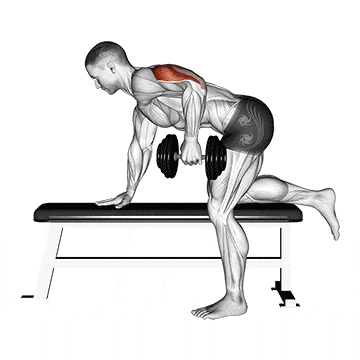
Sets And Reps
Here are some general guidelines for the dumbbell kickback exercise, including sets, reps, and frequency, to enhance muscle mass
| Fitness Level | Sets | Reps | Frequency |
|---|---|---|---|
| Beginner | 2–3 sets per workout | 8-12 | 1–2 times per week |
| Intermediate | 3–4 sets per workout | 8-12 (slightly heavier) | 2–3 times per week |
| Advanced | 4–5 sets per workout | 8-15 | 2–3 times per week |
Best Variations Of DB Tricep Kickbacks
Modifying hand position, angle, stance, and other technique factors can help you target the triceps from various angles.
These kickback variations will help you strengthen your triceps from multiple angles and break through plateaus.
1. Seated Two-Arm Dumbbell Kickback
When seated, you significantly reduce the ability to use momentum from your legs, hips, or excessive torso swing to move the weight. This forces the triceps to do more of the work.
Working both arms simultaneously cuts the time spent on this specific exercise in half compared to performing it unilaterally (one arm at a time). This can be beneficial for longer workouts or when time is limited.
You can also do the single with only a single arm. This unilateral variation helps to improve the mind-muscle connection.

How To Do
- Sit on a bench and grab a pair of dumbbells using a neutral grip (palms facing your body).
- Keep your upper arms fixed to your sides, and lean forward until your torso is almost horizontal.
- Exhale as you extend the dumbbells behind you until your forearms are horizontal.
- Hold for a count of two and inhale as you slowly lower the dumbbells to the starting position.
To Stay Motivated: 150+ Gym Workout Motivational Quotes To Stay Fit
2. Standing Single Arm Dumbbell kickback
If a bench isn’t available (e.g., crowded gym, home workout, travel), the standing single-arm kickback is readily accessible if you have a dumbbell.
While performing a single-arm kickback in a bent-over position, your body must resist rotation and remain stable. This naturally forces your core and glutes to engage, especially if you’re not holding on to a bench or support.
Working with one arm at a time can really help you see if one tricep is a bit weaker or less coordinated than the other. This way, you can give some extra love and attention to the weaker side.
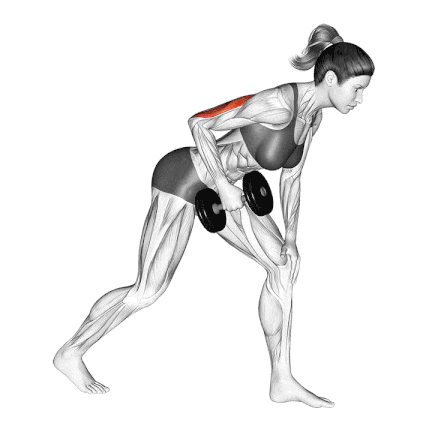
How To Do
- Stand with your feet shoulder-width apart and hold a dumbbell in one hand.
- Keep your back straight as you bend forward at the waist.
- Grab a dumbbell with your right hand, then shift your left foot forward and your right foot backwards.
- Kick your right elbow back, so the upper arm is almost parallel to the ground, and let it go until it’s fully extended.
- Slowly lower the dumbbell back to the starting position.
- Complete all reps on the right arm and then repeat on the left.
3. Two-Arm Dumbbell Standing Kickback
The standing two-arm dumbbell triceps kickback is performed with both arms extended simultaneously while standing.
Working both arms simultaneously helps promote balance and symmetry in triceps development. It is a great exercise for strengthening the triceps and improving arm stability.
It requires limited space and no other special equipment, making it a perfect workout at home option for people who cannot afford to go to the gym daily.
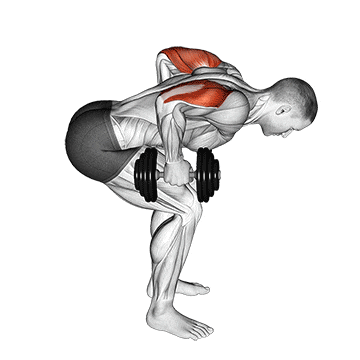
How To Do
- Stand with your feet shoulder-width apart.
- Hold a dumbbell in each hand and bend your upper body forward at the hips.
- Keep your back straight and your chest up.
- Bend your elbows to 90 degrees and position your upper arms parallel to the floor.
- Then, slowly return to the starting position.
- Perform 2 to 3 sets of 10 to 12 reps.
4. Incline Dumbbell Kickback
The incline kickback, also known as the chest-supported kickback, is a variation of the traditional dumbbell kickback that is performed while lying on an incline bench.
Because your upper body is supported on the bench, you eliminate momentum and body sway, which are common in standing versions. This forces the triceps to do nearly all the work, especially the long head.
If your lower back hurts or you have trouble keeping your spine straight during a hip hinge, the incline dumbbell kickback is a great alternative. The bench takes all the load off the lumbar spine.
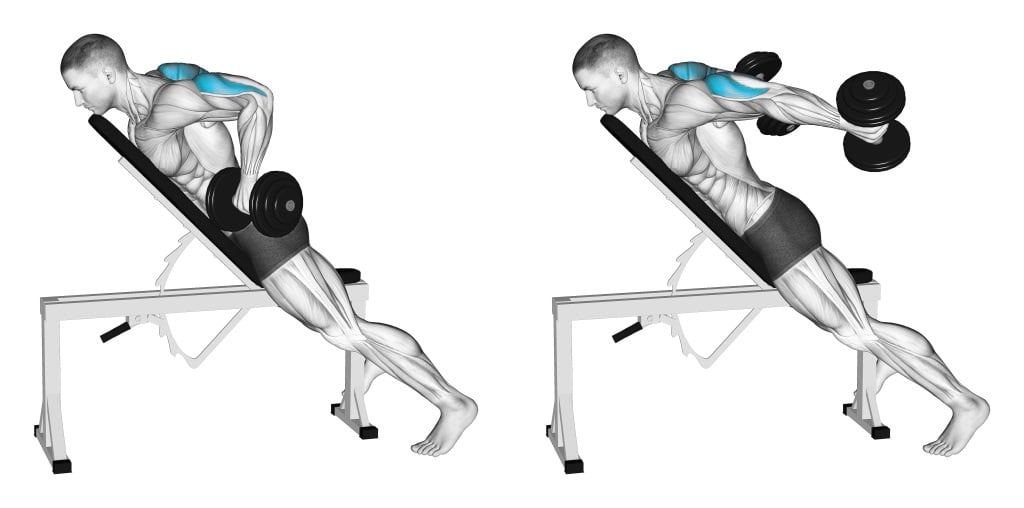
How To Do
- Set an incline bench to a 45-degree angle.
- Lie face down on an incline bench, with your chest supported by the bench.
- Hold a dumbbell in each hand, palms facing each other, and elbows bent at a 90-degree angle.
- Keep your elbow still and extend your arm behind you as far as you can.
- Hold for a moment, then slowly return to the starting position.
- Repeat for 10–12 repetitions per arm.
- Then, switch sides and repeat the exercise with your other arm.
FAQs
Are dumbbell kickbacks effective?
Yes, dumbbell kickbacks can effectively target and strengthen the triceps muscle.
When performed with proper form and technique, and combined with a well-rounded strength training program, kickback can help to build and tone the triceps.
Do Tricep Kickbacks Work All 3 Heads?
Yes, tricep kickbacks work all three heads of the triceps brachii, though the lateral head is activated to a greater degree during this exercise. Here’s how each head is engaged:
- Long Head: Engaged during the extension phase, particularly when the arm is positioned close to the body
- Lateral Head: Most heavily activated during the kickback motion, especially at full extension
- Medial Head: Involved throughout the movement for stabilization and extension
How Much Weight Should I Use For Tricep Kickbacks?
Start lighter than you might expect for tricep kickbacks. Due to the biomechanics of the movement and the isolated nature of the exercise, even experienced lifters often use relatively light weights (5-15 pounds) to maintain proper form.
Weight recommendations based on experience level:
- Advanced: 12-20+ pounds (women) / 20-30+ pounds (men)
- Beginners: 3-8 pounds (women) / 5-10 pounds (men)
- Intermediate: 8-12 pounds (women) / 10-20 pounds (men)
References
- Tanton LC, Cappaert TA, Gordon PM, et al. Strength, Size, and Muscle Quality in the Upper Arm following Unilateral Training in Younger and Older Males and Females. Clinical medicine Arthritis and musculoskeletal disorders. 2009;2. doi:10.4137/CMAMD.S1180
- Boehler, B A. “Electromyographic analysis of the triceps brachii muscle during a variety of triceps exercises.” (2011).

Manish is a NASM-certified fitness and nutrition coach with over 10 years of experience in weight lifting and fat loss fitness coaching. He specializes in gym-based training and has a lot of knowledge about exercise, lifting technique, biomechanics, and more.
Through “Fit Life Regime,” he generously shares the insights he’s gained over a decade in the field. His goal is to equip others with the knowledge to start their own fitness journey.
